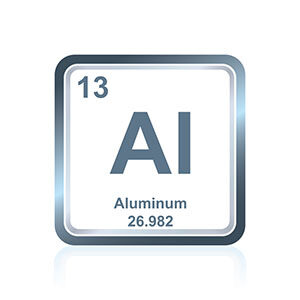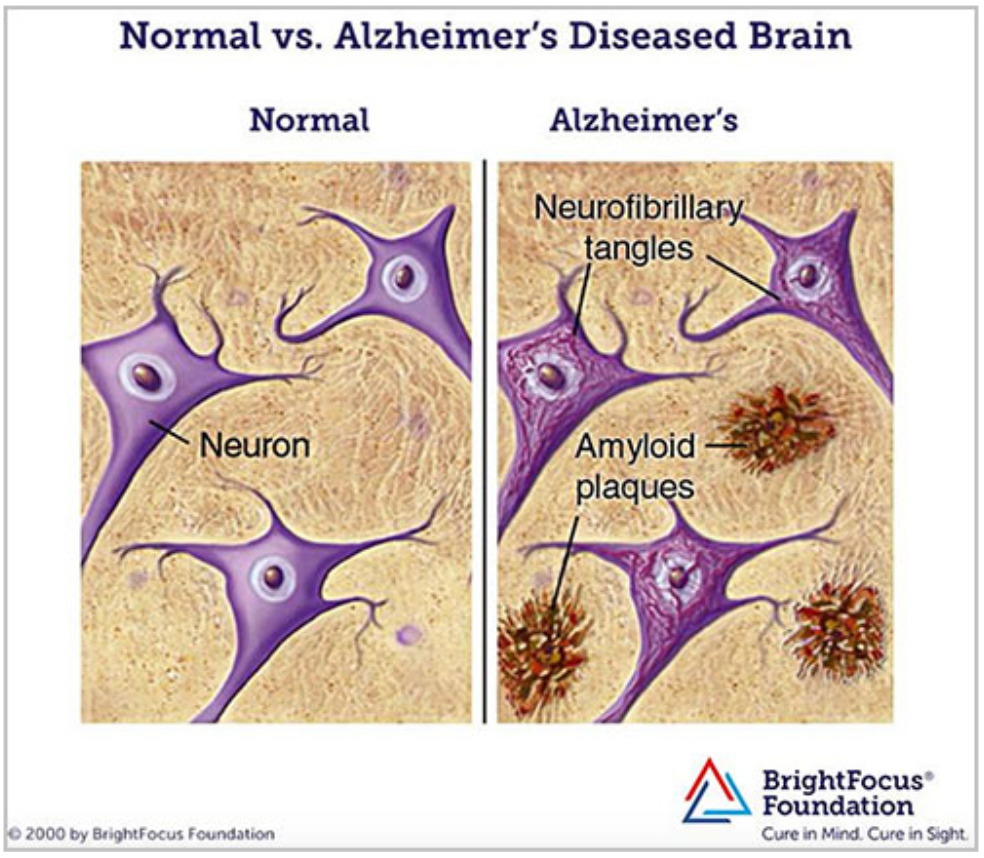Alzheimer’s Disease is Caused by Chronic Aluminum Poisoning
 This article originally appeared in the June 2017 McDougall Newsletter and has been updated in June 2023.
This article originally appeared in the June 2017 McDougall Newsletter and has been updated in June 2023.
By John McDougall, MD
Alzheimer’s disease (AD) is now, worldwide, the most common form of dementia (a decline in mental ability severe enough to interfere with daily life). Primarily found in the elderly, AD was unknown until the beginning of the 19th century. By 1926 only 33 cases had been reported. After World War II in the mid-20th century, the incidence exploded, with more than 24 million people in industrialized societies now disabled and dying from this brain-killing epidemic.
Alzheimer’s was once less common in developing countries, such as China, but their recent changes toward the Western diet caused the incidence of AD to rise proportionally. By 2040 it is predicted that 81.1 million people will develop AD worldwide. The burden on patients, families, and healthcare businesses will become even more enormous. Consider that nursing homecare alone in the US is now, on average, $47,000 per patient per year.
Aluminum toxicity has been considered to be the cause of AD for more than a century. Besides being the third most abundant element on Earth (after oxygen and silicon), aluminum is the most brain-toxic metal we commonly come in contact with. The original source of this metal is earth (dirt, rocks, and clay). Naturally aluminum is not found in the animal kingdom and is only present in plants as compounds that are not readily absorbed by the intestines of animals.
Human exposure to aluminum was rather limited up until the late 1880s. However, since the Industrial Revolution mankind has discovered how to refine aluminum extracted from the Earth’s crust into aluminum compounds, such as aluminum sulfate and aluminum citrate, which are absorbed and concentrated in human tissues. For the past century we have lived in the “Aluminum Age.” Nowadays most people are exposed to unsafe amounts through food, water, and air all day long.
You may be asking: “Why is aluminum poisoning not a major public health topic?” As with most of our chronic disease epidemics, getting the truth out to the public is fought by “Big Businesses.” You know many other examples of money trumping truth; consider the cattle and dairy industries’ efforts. In this case, consultants for the International Aluminum Institute publish articles in medical journals that attempt to convince scientists, medical professionals, and the consuming public that there is “little or no credence” to the Aluminum Hypothesis that identifies their product as the cause of Alzheimer’s Disease. However, a review of the published scientific research should cause you to come to the opposite conclusion. Search the US National Library of Medicine at www.pubmed.gov for “aluminum and Alzheimer’s Disease” to find the 1403 articles (as of June 2023) published on this subject since 1965.
The Undeniable Evidence
In 1901, German neuropathologist Alois Alzheimer identified his first case of AD in a 50-year-old woman. In 1911, he described in The Lancet medical journal characteristic microscopic changes in the brains of AD patients called “neurofibrillary tangles.” These changes within the cells, along with senile (amyloid) plaques that develop outside the brain cells, are referred to as “pathognomonic,” by definition, a particular sign whose presence indicates that a particular disease is present beyond any doubt.

Two published scientific reports are particularly incriminating of aluminum being the causative agent for AD. Research published in Science in 1980 used scanning electron microscopy and x-ray spectrometry to more carefully examine these pathognomonic lesions (senile plaques and neurofibrillary tangles). Under this powerful magnification aluminum was found in the nuclear region of cells from the neurofibrillary tangles in diseased brains in patients with Alzheimer’s Dementia, but not in cells outside of the neurofibrillary tangles and in patients of similar age without AD. Additional research published since has found aluminum poisoning directly accounts for most of the scientific markers associated with AD.
The second convincing report was published in March of 2017 and established a direct human connection between the amount of aluminum accumulation in the brain and the severity of AD. Those who develop Alzheimer’s disease in their late sixties and older accumulate more aluminum in their brain tissue than individuals of the same age without the disease. Some of the highest levels of aluminum ever measured in human brain tissues are found in individuals who have died with a diagnosis of “familial AD” (a rare rapidly progressive genetic variant with onset as early as 30 years).
Timeline of Evidence
1897: Aluminum found to be toxic to the brain and nervous system.
1901: First case of AD reported by German neuropathologist Alois Alzheimer.
1911: Dr. Alzheimer described in the Lancet the characteristic neurofibrillary tangles seen under his microscope of in his patient with AD.
1911: William Gies expressed concerns about the use of aluminum in baking powders, based on seven years of research on the effects of aluminum salts in animals and humans.
1926: Only 33 cases of AD had been reported.
1965: A mechanism for aluminum causing Alzheimer’s Disease was shown by injecting animals (rabbits) with aluminum and producing neurofibrillary lesions (classic pathologic microscopic finding).
1973: Brains of patients with AD were reported to have 2 to 3 times more aluminum than people of comparable age without dementia.
1980: Scanning electron microscopy and x-ray spectrometry found pathognomonic lesions (neurofibrillary tangles) contained a central core of aluminum.
1983: A report was published that patients on chronic hemodialysis treatment for renal failure, receiving high concentrations of aluminum, developed “dialysis encephalopathy” with concentrations of aluminum in their body as much as 12 times normal.
1986: A higher aluminum content of drinking water was correlated with an increased the incidence of death from dementia worldwide. Eighteen studies have found this association. Aluminum is added by the water utility to increase the clarity of the water.
1991: Treatment with Desferrioxamine (DFO), a chelating agent with a high affinity for aluminum, was found to reduce the amount of aluminum in the brain and body tissues and to slow the progression of AD in patients.
2015: More than 24 million cases of AD reported worldwide.
2017: Aluminum concentrations in the brains were reported to be directly correlated with the severity of AD in patients.
Primary Prevention: Avoid Aluminum Exposure
The primary approach to avoiding AD is to avoid exposure to aluminum through the gastrointestinal tract (eating and drinking), by breathing aluminum, and by skin exposure. Absorption of aluminum from the intestinal tract is small (less than 1%), however the total amount consumed of this metal in modern societies is large and becomes significant. Plant foods, including teas, are known to contain aluminum. Fortunately, as nature designed, most of it is bound to oxalate, silicates, and other elements that prevent absorption into the body. There is no association between drinking tea with large amounts of non-absorbable aluminum compounds in its leaves and AD.
The skin and lungs also provide common portals of entry for this bio-toxic metal. Many occupations have exposed workers to large amounts of aerosol aluminum in their working environment. Antiperspirants contain aluminum as an ingredient to inhibit the sweat glands. Not only is the aluminum absorbed when applied to the skin, but it is also inhaled as people spray their armpits daily. The olfactory lobes (parts of brain connecting the nose with the brain) provide a direct connection between the outside environment and the brain, and more specifically, into those areas of the brain known to be most severely affected by AD. Breathing aluminum may account for far more entry of aluminum into the body tissues than eating and drinking it.
Common Sources of Aluminum Exposure
-Drinking water
-Coffee beverages using aluminum mokas
-Aluminum containers, foils and cans
-Aluminum cookware and utensils
-Food additives
-Infant formulas
-Medications
-Personal hygiene products
-Vaccinations
Treating and Preventing AD
Avoiding aluminum exposure is your surest defense from developing AD. There are no doctor-prescribed medications that will slow or stop the progression of this form of dementia. However, aluminum removal from the body via the kidneys can be enhanced with clinical benefits also reported.
Desferrioxamine (DFO), a chelating agent with a high affinity for aluminum, was first reported in 1991 to remove this toxic metal from the body tissues and to slow the progression of AD in patients. The treatment was twice a day injections of 125 mg of DFO for five days a week. Over two years of observation, the rate of decline in the clinical state of 48 patients was twice as rapid in the “no-treatment” group compared with the “DFO-treated” group. Research continues today using a variety of agents that remove metals from the body as a way to slow and stop the progression of AD.
A simple, inexpensive approach of drinking silicon-rich waters is now being promoted as a way of enhancing the elimination of aluminum from the body, along with the hopes of helping people prevent and treat AD. Researchers asked patients with Alzheimer’s to drink a liter (about 34 ounces) of a silicon-rich mineral water each day for 12 weeks. This “special water” increased the removal of aluminum via the kidneys into the urine and clinical improvement was seen in 3 of the 15 patients with AD. These silicon-rich beverages are easily found in stores and via the Internet.
A Safe, Practical Solution for AD
Aluminum is not a nutrient, thus there is no reason for it to be in your body. As always, money drives the message, and there is too much at stake to deliver simple, cost-free, side effect-free information about aluminum poisoning. Only avoiding aluminum is not all you should do. The Western diet in general has been associated with the risk of developing many forms of dementia, including vascular strokes and AD. Rather than spending your “golden years” with silver colored aluminum littered throughout your brain, now is a good time to make the change to The McDougall Program.
My recommendation is to (1) throw out your aluminum pots and pans (use modern non-stick ceramic titanium-based cookware), (2) eat a starch-based diet prepared without aluminum additives, and (3) avoid aluminum-containing hygiene products. Adding silicon-rich drinking water appears to also be a safe and effective over-the-counter technique to remove aluminum that has already accumulated in your body.
Recommended Articles

Three Essential Keys To a Healthy Diet

A Healthy Vegan Diet Can Save Our Planet





